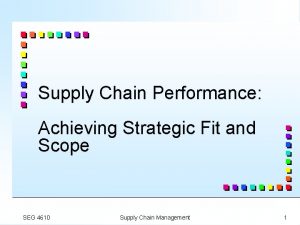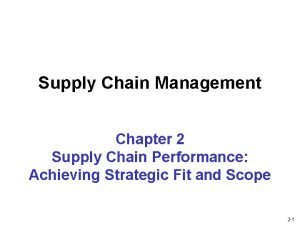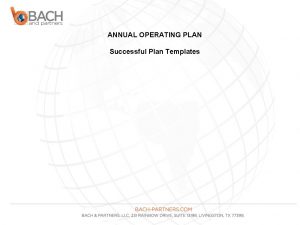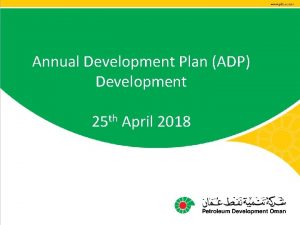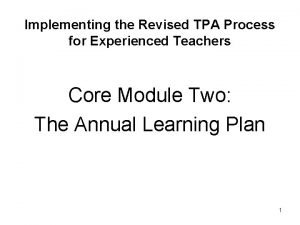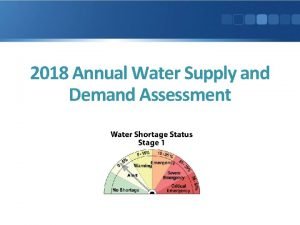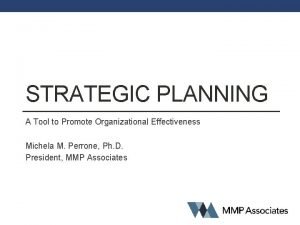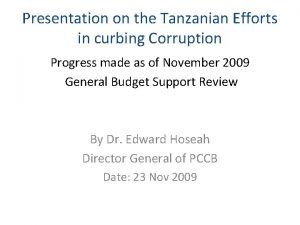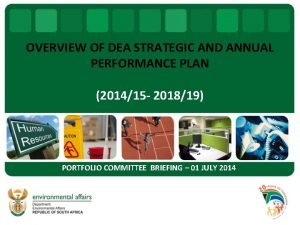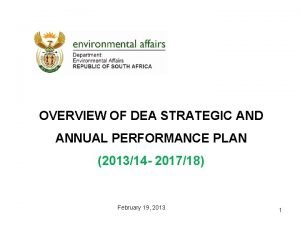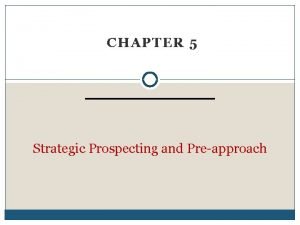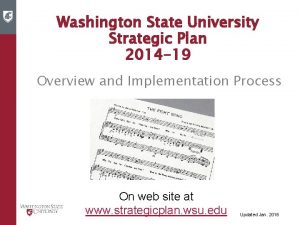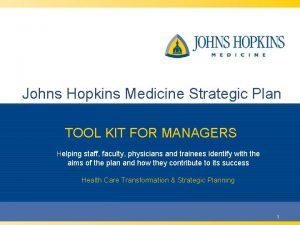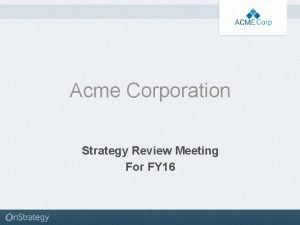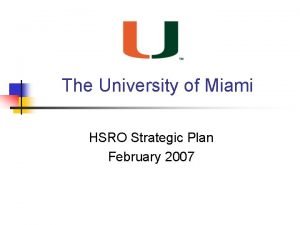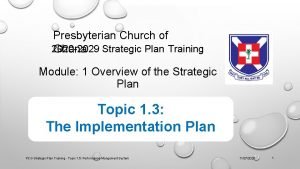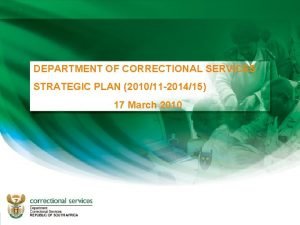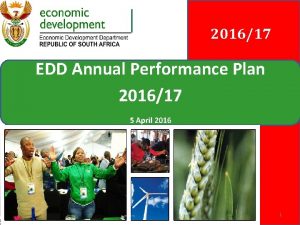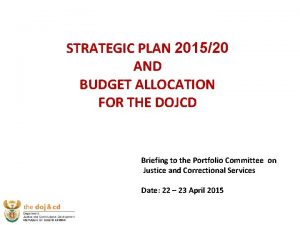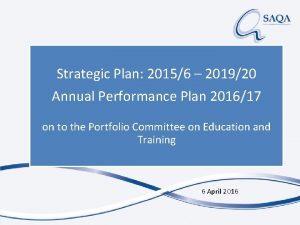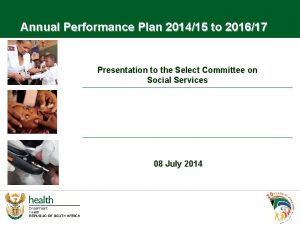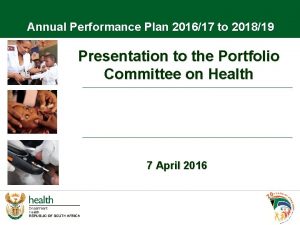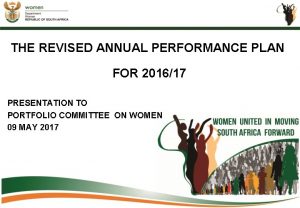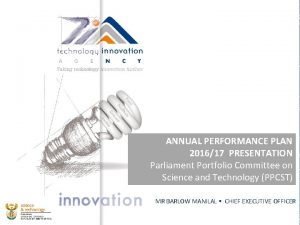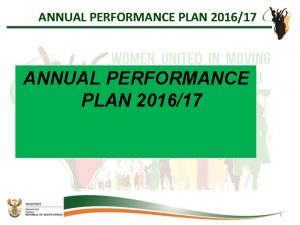STRATEGIC PLAN 201520 ANNUAL PERFORMANCE PLAN 201617 AND







































































- Slides: 71

STRATEGIC PLAN 2015/20 ANNUAL PERFORMANCE PLAN 2016/17 AND BUDGET ALLOCATION FOR THE DOJCD Briefing to the Portfolio Committee on Justice and Correctional Services Date: 6 April 2016

CONTENTS 1. Introduction 2. Mandates 3. Mission and Vision 4. Values 5. Key priorities 6. Strategic goals 7. Policies and related initiatives 8. Changes to APP 9. Budget overview 10. Programmes 11. Key risks 12. Conclusion 2

1. INTRODUCTION a. b. CONTENTS The Department held two strategic planning review sessions; the first one was from the 15 th -17 th of July 2015; and second one was from the 11 -12 of November 2015. Some of stakeholders from the JCPS cluster were also represented in those sessions (DCS, NPA, OCJ, Legal aid South Africa) c. During the planning session the following were accomplished: i. iii. iv. Received guidance from the Executive and Director-General regarding the department 2020 and 2030 visions; Mission, vision, priorities and strategic goals of the Department were not revised; Indicators were aligned with the NDP, refined MTSF and focus more on service delivery; and Resolutions taken during the strategic sessions were also considered when the plans were drafted. d. Both the strategic plan and APP of the DOJCD include the NPA as Programme 4. 3

2. MANDATES CONTENTS Constitutional mandate a) The Department’s key constitutional mandate is the administration of Justice, which it derives from Chapter 8 of the Constitution – “Courts and Administration of Justice” and to promote constitutional development through the development and implementation of legislation and programmes aimed at advancing and sustaining constitutionalism and the rule of law. b) Constitution Seventeenth Amendment Act, 2012, which was enacted in 2013 has introduced significant amendments to Chapter 8 of the Constitution. Important amendments are the new section 165(6) which affirms the Chief Justice as Head of the Judiciary and assign to him/her the responsibility to oversee the development and monitoring of norms and standards for the performance of all courts c) The Department will continue with administrative support to the Judiciary where appropriate. 4

2. MANDATES CONTENTS Legislative mandates The Department derives its statutory mandate from various statutes and subordinate legislation. The following are categories of functions emanating from different legislative instruments, that are relevant to the Department: a) Legislation providing for the establishment and functioning of Superior Courts and Lower Courts as well as specialist courts which are both at the level of the High Court and Magistrates Courts. Important legislation among these are the following: i. The Superior Courts Act, 2013. The Act provide for assignment of certain functions to the Office of the Chief Justice (OCJ) which among others include support to the Heads of Courts, Judicial Service Commission and the Judicial Education Institute. ii. The Magistrates Courts Act, 1944 (Act No. 32 of 1944). The Act empowers the Minister to create various magistrates’ court districts, regional divisions and subdistricts, and to define their local limits, appoint magistrates, additional magistrates and regional court magistrates as well as persons to act in those offices when necessary and to determine various amounts and fees related to the monetary jurisdiction of the courts, witness fees and others iii. Small Claims Courts Act, 1984 (Act No 61. of 1984). The Act empowers the Minister to establish small claims courts, determine their seats and areas of jurisdiction, appoint commissioners and determine various amounts related to the jurisdiction of the courts 5

2. MANDATES CONTENTS Legislative mandates b) Legislation providing for the appointment of judges and other judicial officers, their conditions of service, discipline and training. Important legislation among these are the following: i. Judges’ Remuneration and Conditions of Employment Act, 2001: The Act imposes responsibilities on the Minister to make inputs regarding the remuneration and conditions of service of judges and determining certain nonremunerative benefits of judges. ii. Judicial Service Commission Act of 1994: The Minister must determine the allowances payable to members of the Judicial Service Commission and Judicial Conduct Tribunals and consider in consultation with the Chief Justice requests from judges to perform non-judicial work for reward and appoint the Registrar of Judges’ Registrable Interests. iii. These legislation will be delegated to the Office of the Chief Justice when human capacity becomes available. 6

2. MANDATES CONTENTS Legislative mandates c) Legislation providing for the prosecution of offenders and combating of crime: National Prosecuting Authority, the Special Investigating Unit and the Asset Forfeiture Unit, the conduct of criminal proceedings, the investigation of organised crime and corruption, and the forfeiture of assets obtained through illicit means d) Legislation providing for the establishment and functioning of bodies responsible for legal aid (the Legal Aid Act of 1969); e) Legislation providing for the establishment of bodies responsible for law reform and rule-making, the South African Law Reform Commission Act of 1973 and the Rules Board for Courts of Law Act of 1985); f) Legislation providing for the administration of estates The Act provide for the appointment of masters of the high courts and the administration of the Guardian’s Fund and deceased (the Administration of Estates Act of 1985 and the make regulations prescribing the procedure to be observed in connection with insolvent estates and determine policy for the appointment of a curator bonis, trustee, provisional trustee or co-trustee by the Master of the High Court (Insolvency Act of 1936); 7

2. MANDATES Legislative mandates g) Legislation regulating the provisioning of legal advisory services to government departments (the State Attorneys Amendment Act of 1957). The Act make provisions for the Minister to establish the Office State Attorney and the appointment of state attorneys and staff and make regulations in respect of a range of matters related to the Act; h) Legislation relating to the promotion, protection and enforcement of human rights. The Promotion of Administrative Justice Act of 2000 make provisions for the Minister to designate magistrates’ courts which shall, either generally or in specific classes of administrative actions, have jurisdiction to hear cases emanating from the application of the Act and make regulations in respect of a range of matters related to the Act; i) the Promotion of Access to Information Act of 2000, the Act make provisions for the Minister designate magistrates’ courts which shall have jurisdiction to deal with matters emanating from the application of the Act, and make regulations in respect of a range of matters related to the Act; j) Promotion of Equality and Prevention of Unfair Discrimination Act of 2000); the Act make provisions for the Minister to designate magistrates’ courts as equality courts for specific areas and to make regulations in respect of a wide range of matters related to the Act. 8

3. VISION AND MISSION 1. INTRODUCTION Vision and mission remain unchanged Vision- An accessible justice system that promotes constitutional values. Mission To provide transparent, responsive and accountable justice services. 9

4. VALUES 1. INTRODUCTION The values remain unchanged i. Commitment to constitutional values ii. A culture of human rights iii. Promotion of the Rule of Law iv. Batho Pele v. Good governance vi. Ubuntu vii. Professionalism and continuous improvement viii. Transparency 10

5. KEY PRIORITIES OF THE DEPARTMENT Key Priorities remain unchanged a. Priority 1: Good governance and clean administration, resulting in no audit qualification: This priority is aligned with Chapter 13 of the National Development Plan: Building a Capable State; b. Priority 2: Service turnaround in the State Attorney: This priority is aligned with Chapter 13 of the National Development Plan: Building a Capable State; c. Priority 3: Service turnaround in Maintenance Services: This priority is aligned with Chapter 11 of the National Development Plan: Social Protection; and d. Priority 4: Youth employment opportunities: These initiatives are aligned with the following chapters of the NDP: Chapter 3: Economy and Employment, Chapter 13: Building a Capable State and Chapter 14: Promoting accountability and Fighting Crime; 11

6. STRATEGIC GOALS The department goals have been translated to align with those of the National Development Plan and National Outcomes. For the new financial year, this goals remain unchanged Aligned Budget Allocation Goal 1 An efficient, effective and development oriented administration. (Outcome 12) An amount of R 177. 8 million has been allocated to improve internal audit, risk management and vetting, for 2016/17 financial year. Goal 2 Improved administration support to the justice system enabling efficient resolution of cases. (civil, family law and criminal)(Outcome 3 and 13) An amount of R 78. 5 million has been allocated to address rural capacitation of courts, for 2016/17 financial year. 12

6. STRATEGIC GOALS The department goals have been translated to align with those of the National Development Plan and National Outcomes. For the new financial year, the goals remain unchanged Aligned Budget Allocation Goal 3 Provision of quality legal services that strengthens the capacity of the State (Outcome 12) The focus on the reengineering of the State Legal Services required an investment of an additional R 36 million for 2016/17. A total of R 113. 6 million is allocated to this goal over the MTEF period. Goal 4 Promote constitutionalism and Social justice to contribute to social cohesion (Outcome 14) An amount of R 76 million in 2016/17 financial year has been allocated to this crucial focus area to ensure awareness of the relevance of our constitutional democracy and the rights and obligations of citizens in this regard 13

7. POLICIES AND RELATED INITIATIVES NATIONAL POLICIES a) Legal Practice Act The key objective of the Legal Practice Act is to rationalise various pre-1994 statutes which regulated the legal profession in different parts of the country. The Act does not only enhance access to the legal profession for aspirant lawyers, but will also enhance access to legal services, impacting positively on access to justice. i. The proclamation by the President to commence implementation of Parts 1 and 2 of Chapter 10 of the Act was published in January of 2015. ii. Implementation of the Act has begun during the 2015/16 financial year with the establishment of the National Forum iii. The National Forum is functioning currently through the various work committees , i. e. Governance Committee, Rules and Regulations Committee, Education Committee and Administration and Human Resource Committee. iv. The focus for 2016/17 is to finalise the establishment of the Legal Practice Council and its structures and the costing and funding thereof. Negotiations with the existing governing bodies are currently underway. 14

7. POLICIES AND RELATED INITIATIVES 1. INTRODUCTION a) Legal Practice Act vi. Estimated funding for this implementation of the legal practice Act is as presented in the table below: Approved budget Year on Year Growth 2016/17 ‘ 000 2017/18 ‘ 000 2018/19 ‘ 000 17 496 18 452 19 375 7. 7% 5% 15

7. POLICIES AND RELATED INITIATIVES NATIONAL POLICIES b) Transformation of State Legal Services The transformation of State Legal Services is aimed at addressing the apparent lack of effective coordination of legal services that has led to a number of operational challenges experienced across government. The challenges amongst others include the following: i. Prescription of claims involving government; ii. Default judgments granted against government; iii. Lack of monitoring systems over the work and outputs of attorneys and advocates; iv. Inconsistency in the determination of counsel fees; and v. Low success rates in cases against the State. During the 2015/16 financial years, the department initiated the development of policiess aimed at transforming the delivery of State Legal Services broadly. The developed policies are : Policy on Briefing Counsel and a Fee parameter and a Framework for the Management of State Litigation, a Policy for State Legal Representation and a Policy on Mediation. The department has also drafted a Litigation Strategy for 2016 to 2020, which sets out the medium to long term strategies for to achieve a turnaround in the performance of the State Attorneys. The department will continue to consult with client departments and the profession on these policies and strategies. 16. . cont’d

7. POLICIES AND RELATED INITIATIVES NATIONAL POLICIES b) Transformation of State Legal Services i. The State Attorney Amendment Act of 2014 provided for the establishment of a Solicitor-General, who will focus efforts in coordinating litigation on behalf of the State and improve the overall management within offices of the State Attorneys. ii. During the 2015/16 financial year, the Department initiated recruitment processes for the post of Solicitor-general. The advertisement for the post was published during the month of February 2016. iii. Service turnaround in the State Attorney offices is one of the priorities of the department. The department will focus on containing litigation costs for the state through: • • • Implementing clear guidelines regulating how state litigation is to be conducted; Clarifying the roles and responsibilities of in state litigation management; and Implementation of cost-saving measures. 17

7. POLICIES AND RELATED INITIATIVES b) 1. INTRODUCTION Transformation of State Legal Services Appointment of the Solicitor-General in line with the State Attorney Act is underway with the estimated funding of the related activities over the MTEF period is as presented below: Approved budget Year on Year Growth 2016/17 ‘ 000 2017/18 ‘ 000 2018/19 ‘ 000 4 679 4 936 5 223 5% 6% 18

7. POLICIES AND RELATED INITIATIVES NATIONAL POLICIES c) i. Alternative Judicial Administration Framework The development of the Alternative Judicial Administration framework for legislation will result in establishing an independent court administration framework as required by the National Development Plan. The framework and subsequent legislation will have major implications on the Departmental mandate. ii. Consultations regarding this framework will take place during the current MTSF period. d) i. Policy Framework on rule-making A policy framework to rationalise the various existing rule making structures and functions is necessary. Currently there are different rule-making dispensations for different courts, namely, the Chief Justice who makes rules for the Constitutional Court; the Rules Board which makes rules for magistrate courts; and the High Courts, Supreme Court of Appeal and Labour Courts with their own rules board; ii. The policy framework will pave way for the implementation of Section 29 of the Superior Courts Act, 2013 which has been put in abeyance. iii. The rationalisation process is expected to be finalised during the current MTSF cycle. 19

8. CHANGES TO APP New output indicators include in the APP 3 new output indicators that in line with judicial norms and standards were included under the Objective 5. Details are presented in table below Old New Objective 5 Improved finalisation of criminal cases in support of Outcome 3: All people in South Africa are and feel safe”. Remains unchanged Objective indicator Number of cases on the backlog roll Remains unchanged Output indicators CJS business plan completed by target date Number of indicators on the CJS Business Plan achieved Percentage of criminal matters finalised within 6 months after the accused has pleaded to the charge 5. 2 Percentage of accused person pleaded to the charge within 3 months from date of first appearance in the magistrates courts 5. 2 Percentage of criminal case postponed due to unavailability of court admin staff Remains unchanged The 2 new indicators included under Objective 5 will go a long in addressing speedily finalisation of the cases in our courts and improving public confidence in the criminal justice 20 system that is already low.

8. CHANGES TO APP New output indicators include in the APP 1 new output indicator was included under the Objective 15. Details are presented in table below Old New Objective 15 Development of instruments that constitutional challenges legislative withstand Remains unchanged Objective indicator Percentage of legislative instruments successfully challenged in court for constitutionality Remains unchanged Output indicators 15. 1 Number of legislative instruments Remain Unchanged submitted to the Minister for approval 15. 2 Number of research papers completed 15. 3 Number of court rules completed 15. 4 Number of Socio-economic Impact Assessments submitted to DPME for certification 21

8. CHANGES TO APP New output indicators include in the APP 6 new output indicators were included under the Objective 16. Details are presented in table below Old New Objective 16 Promotion of broad based knowledge about and support for values of equality, human dignity and fundamental human rights. Remains unchanged Objective indicator Percentage of people with awareness of the Constitution Remains unchanged Output indicators Number of activities completed to improve Number of grants awarded to civil society organizations working in the human rights awareness of constitution sector Number of activities to improve sector Number of research projects conducted on the implementation socio-economic rights coordination and socio-economic rights Number of activities completed to improve Policy framework on Prevention and Combating of Trafficking in Persons capacity of civil society in constitutional rights submitted to Parliament by target date. Number of policy dialogues held with stakeholders in human rights sector National Action Plan to combat racism, racial discrimination, xenophobia and related intolerance submitted to Cabinet by target date Number of Sustained and visible antixenophobia campaigns conducted

8. CHANGES TO APP New output indicators include in the APP 3 new output indicators were included under the Objective 16. Details are presented in table below Old New Objective 20 Establishment of an integrated electronic criminal justice system (CJS) to modernise the management of the criminal justice information. Functional integrated electronic criminal justice system (CJS) to monitor the performance of the criminal justice system established Objective indicator Number of KPIs on the Integrated Criminal Justice Systems Remains unchanged Output indicators 21. 1 Percentage completion of ICMS Criminal enhancement 21. 2 Number of KPI data uploaded into IJS data warehouse 21. 3 Percentage completion of Integrated justice system hub and data warehouse platform enhancement 23

8. CHANGES TO APP New objective indicator include in the APP New objective indicator was included under the Objective 9. Details are presented in table below Old New Objective 9 Improved level of compliance with quasi-judicial standards of service. Remains Unchanged Objective indicator Percentage of clients satisfied with quasi-judicial services Number of cases dealt with in accordance with quasi-judicial standards of services Output indicators 9. 1 Percentage of requests for Remains unchanged default judgments dealt with by the clerk of the court within 14 working days of receipt (district courts) 9. 2 Percentage of unopposed taxations processed within 14 working days from the date the matter is set down (district courts) 24

8. CHANGES TO APP New output indicators include in the APP New objective indicators were included under the Objective 16. Details are presented in table below Old Objective 10 Objective indicator Output indicators Increased efficiency in the provision of Masters services to all beneficiaries thereof; Number of visits to the Master’s Web portal New Remains Unchanged Number of cases handled by Master of the High Court All output indicators on Deceased Remain unchanged Estates, Guardian’s Fund, liquidations, bankruptcies and trusts. 25

8. CHANGES TO APP New objective indicator include in the APP New objective indicator was included under the Objective 11. Details are presented in table below: Old New Objective 11 Improved management of litigation on behalf of the state to reduce litigation costs and transform the legal profession; Improved management of litigation on behalf of the state to transform the legal profession Objective indicator Percentage of savings on damages claimed Percentage reduction in litigation costs against the State Output indicators 11. 1 Percentage value of briefs allocated to Previously Disadvantaged Individuals (PDI) Counsel Remains unchanged 11. 2 Percentage of finalised damages claims where savings were made 11. 3 Number of policies submitted to the Executive for endorsement 11. 4 Number of positions filled No longer on the plan 11. 5 Number of managers trained on management 26

8. CHANGES TO APP 1. INTRODUCTION NPA objectives and their indicators b) In line with current legislation and National Treasury arrangements, the NPA is a Programme within the DOJCD. The following objectives from the National Prosecuting Authority have been included in the DOJCD APP and Strategic Plan: i. iii. Increased successful prosecution Ensure that profit is removed form crime; and Ensure threatened witness and related persons are successfully protected. c) 25 indicators were included to monitor the achievement of the 3 listed NPA objectives. d) Detailed information on the indicators is provided on slides 61 to 69 of this presentation. 27

9. BUDGET OVERVIEW MTEF BUDGET ALLOCATIONS (R million): Year on Year Growth 2015/16 Estimated baseline allocations 16, 841, 542 Additional allocation Adjusted baseline Less: Budget cuts Approved budget Year on Year Growth 2016/17 2018/19 18, 005, 276 19, 086, 772 20, 193, 807 207, 844 591, 448 720, 142 18, 213, 120 19, 678, 220 20, 913, 949 (123, 222) 16, 841, 542 2017/18 (554, 547) (804, 065) 18, 089, 898 19, 123, 673 20, 109, 884 7% 6% 5% 28

9. BUDGET OVERVIEW MTEF BUDGET ALLOCATIONS: Year on Year Growth i. Due to the current economic climate the Department has received a below inflationary rate increase in budget as illustrated above. This is the result of a cut in the previous MTEF indicative allocations as follows: R 114. 2 million under auxiliary and associated servicers programme. i. The Department therefore reprioritised within the existing baseline to fund its new programmes and priorities. 29

9. BUDGET OVERVIEW Indicative Budget Allocations per Programme 30 30

9. BUDGET OVERVIEW MTEF BUDGET ALLOCATIONS: Year on Year Growth 8 000 7 000 1. Administration 6 000 2. Court Services 5 000 3. State Legal Services 4 000 4. National Prosecuting Authority 3 000 5. Auxiliary and Associated Services 2 000 Magistrates' salaries 1 000 2012/13 2013/14 2014/15 2015/16 2016/17 2017/18 2018/19 31

9. BUDGET OVERVIEW Other Departmental Priorities within the baseline 2015/16 ‘ 000 2016/17 ‘ 000 2017/18 ‘ 000 2015/16 ‘ 000 1 032 886 1 170 146 1 228 622 1 299 882 Capital works 661 523 911 129 956 124 1 011 159 Security (Additional funds) 88 000 92 840 97 482 102 356 IJS/CJS 469 952 389 695 433 719 458 875 Property Management 32

9. BUDGET OVERVIEW 1. INTRODUCTION Implications of Budget Adjustments 1. Improvement in Conditions of service for 2015/16 was higher than the provision in the estimates. The carry through cost in this regard is higher than the capped amount in 2018/19. 2. The department is in the process of reviewing its service delivery model so as to ensure that services at court level are not compromised. 3. Fro 2016/17 financial year, the IJS project was cut by R 114. 2 million. Due to the significance of this project reallocation of funds will be considered. 33

9. BUDGET OVERVIEW 1. INTRODUCTION Areas of spending pressures during the 2016 budget process 1. Maintenance of security infrastructure in the departmental service 2. Introduction of Paralegals in Regional and District courts 3. Introduction of mediators according to the Draft Rules on Mediation as per the Magistrate Court Act 4. Small Claims Court Re-engineering Program 5. Technical capacity within the department to fast track projects to be implemented by the Department of Public Works 6. Roll-out of the Office of the Protection of Personal Information Regulator 34

PROGRAMME 1: STRATEGIC PLAN 35

PROGRAMME 1: ADMINISTRATION Under this programme, the following key objectives have been identified: 1. Increased compliance with prescripts to achieve and sustain the unqualified audit opinion; 2. Implementation of programmes aimed at supporting employment opportunities for youth; 3. Reduction of fraud and corruption cases in the department; and 4. Increased number of public bodies compliance with the Promotion of Access to Information Act (PAIA) of 2000. 36

PROGRAMME 1: ADMINISTRATION Objective 1: Increased compliance with prescripts to achieve and sustain an unqualified audit opinion. a) This initiative is aligned to Chapter 13: Building a capable State through improving governance in the department b) The Department has achieved unqualified opinions on the DOJ&CD Vote Account, the Guardian Fund and the President Fund or 2015/16 financial year. The AG has acknowledged the President fund for continued excellence. c) The Department is in the process of implementing a new accounting system for TPF to address the concerns on the existing legacy system. Furthermore the Department has improved oversight and control in the environment. Management review the financial position of all courts on a monthly basis management. e) The Department plans to continue to achieve unqualified audit opinions for the vote and other accounts it manages through its monitoring and evaluation processes as part of its combined assurance framework. (Audit Facilitation, Quality Assurance, Internal Audit) f) The Department intends to achieve an unqualified opinion on Third party Funds by 2017/18. APP : p 19 -20 Strategic Plan: p 36 -37 37

PROGRAMME 1: ADMINISTRATION 1. INTRODUCTION Objective 2 : Implementation of programmes aimed at supporting employment opportunities for the youth a) This objective is aimed at measuring the department’s initiatives towards addressing the scourge of youth unemployment in our country. b) Initiative under this objective are aligned with the Chapter 3 : Economy and employment and Chapter 13: Building a capable State. c) In addressing scourge of youth unemployment and related complexities, the department key areas of focus during this MTSF period will be on the following: i. To provide learnership opportunities to 2550 youth through this programmes in area of law, ICT and public management. . ii. Ensuring our procurement spend support youth employment. The mechanisms and the baseline will be finalised during the 2016/17 financial. APP : p 21 -22 Strategic Plan: p 37 -38 38

PROGRAMME 1: ADMINISTRATION PROGRAMME INDICATORS AND TARGETS Objective 3: Reduce fraud and corruption in the department i. Reduction in incidences of fraud and corruption is one of government priorities as articulated in Chapter 14: Promoting Accountability and Fighting Corruption ii. The Department will continue to align with government programmes on this matter, including among others, participation in the Anti-Corruption Task Team and implementation of required procedures and initiatives. iii. For 2016/17 financial year, the Department will continue to run anticorruption workshops and ensure speedy forensic investigation where suspected cases have been identified so as to facilitate timely consequence management. In addition, vetting of SMS as well as other identified areas such as supply chain management officials, will continue. iv. To monitor the impact and effectiveness of anti-fraud and corruption activities, the Department will run perception surveys on fraud and corruption to evaluate if the planned initiatives are yielding better results. The fraud and evaluation report will be finalised during first half of 2016/17 financial year. APP : p 22 -23 Strategic Plan: p 38 -39 39

PROGRAMME 1: ADMINISTRATION PROGRAMME INDICATORS AND TARGETS Objective 4: Increased number of public bodies’ compliance with the promotion of access to information act (PAIA) of 2000 i. Aligned with Chapter 14 of NDP: Promoting Accountability and Fighting Corruption ii. The DOJCD is a lead department in ensuring that government complies with this Act iii. The Act is critical to Section 32 of the Constitution of right to access to information. iv. As at the end of February 2016, the department processed all applications for access to information in its custody from all persons or institutions within the prescribed time frames. In addition to that , the Department also provides training 42 Public Bodies to implement PAIA. v. In an effort to create openness, responsiveness and accountability by public service and increase compliance level with the legislation, the department will in the new financial continue to monitor compliance with implementation of PAIA by public bodies, process all Do. JCD PAIA requests within the required timeframes and capacitate public bodies. APP : p 24 -25 Strategic Plan: p 39 40

PROGRAMME 2: STRATEGIC PLAN 41

PROGRAMME 2: COURT SERVICES Under this programme, the following key objectives have been identified: 1. Improved finalisation of criminal cases in support of Outcome 3: People are and feel safe; 2. Provide improved court-based services to achieve clients’ satisfaction within the vulnerable groups; 3. Increased protection of the best interest of children and promotion of family cohesion through mediation services; 4. Increased access to justice services to historically marginalised communities; and 5. Improved level of compliance with quasi-judicial standards of service. 42

PROGRAMME 2: COURT SERVICES Objective 5: Improve finalisation of criminal cases in Outcome 3 “All people in South Africa are and feel safe” i. support of This objective is aligned to Chapter 12 of the NDP: Building Safer Communities and Sub. Outcome 2 of the Outcome 3: An efficient and effective criminal justice system; ii. The target for the objective indicator is to reduce criminal cases on the backlog roll from an estimated 29 480 in 2014/15 to 21 795 in 2019/20 iii. In addressing this objective, the Department will a. Focus on minimising the number of case postponements resulting from the Department’s administrative delays. b. Implement Judicial norms and standards. In line with the norms and standards, two indicators were also included in the Plan which will assist in speedily finalisation of cases. c. Monitor the implementation of Criminal Justice System (CJS) business plan developed during the 2015/16 financial year. 43 APP : p 29 -30 Strategic Plan: p 42 -43 43

PROGRAMME 2: COURT SERVICES PROGRAMME INDICATORS AND TARGETS Objective 6 : Provide improved court-based services to achieve customer satisfaction within the vulnerable group i. The Department facilitates the implementation of legislation in promotion of the rights of vulnerable groups. This function is in line with Chapter 11 Social Protection and Chapter 12: Building safe Communities of the National Development Plan ii. The objective is to ensure that clients that are assisted are satisfied with the quality of service. The impact of our services will be measured annually through a customer survey. The survey report will be finalised during the first half of the 2016/17 final year iii. For 2016/17 financial year, the department will also continue to focus on: • Improve services and turnaround times in maintenance orders and payment successes. ( Extension of maintenance turnaround programme from 9 pilots sites to 90 sites ) • Continue establishing dedicated sexual offences courts (30 additional sexual courts over the MTEF period) • Purification and inclusion of historical date into the National Register of Sexual Offenders APP : p 31 -33 Strategic Plan: p 43 -44 44

PROGRAMME 2: COURT SERVICES PROGRAMME INDICATORS AND TARGETS Objective 7: Increased protection of the best interest of children and promotion of family cohesion through mediation services i. This objective is aligned with Chapter 13 of the NDP: Social Security. ii. The objective of this programme is to assist children whose families are going through challenges. iii. Capacitation of this office, through opening of additional service points will continue. iv. During this MTSF period the Chief Family Advocate will continue to increase the number of children who will be assisted through the family advocate intervention to 58 320 by the end of 5 years by: • Improving mediation services towards full compliance with legislation; • Improving turnaround times in lodging children’s reports with the courts; and • Widening the net of child protection against the harmful effects of international child abduction, in line with the Hague Convention APP : p 33 -34 Strategic Plan: p 44 -45 45

PROGRAMME 2: COURT SERVICES Objective 8: Increased access to justice services to historically marginalised communities i. Aligned to Chapter 12 of the NDP: Building Safer Communities ii. The Department will continue to implement programmes that increase access to justice services, particularly in disadvantaged communities. These include: • Rollout of small claims court to every municipality in the country (remaining 44 over the next 2 years) • Alignment of magisterial districts with municipal boundaries (5 remaining provinces over 2 financial years) • Implementation of the Superior Courts Act to ensure that every province has a high court (6 over the next 3 financial years) iii. Customer surveys will be used to assess the extent to which the Department has increased access to justice services. In addition, this process will assist the Department to gauge our client’s appetite for using other service channels, both physical and virtual. iv. Targets for the MTEF period will be set up as a consequence of the survey. The survey report will be completed during the 2016/17 financial year. APP : p 35 -36 Strategic Plan: p 45 -46 46

PROGRAMME 2: COURT SERVICES Objective 9: Improved level of compliance with quasi-judicial standards of services i. There is a need for the Department to improve quasi-judicial functions, particularly within the civil section of the courts. These include: • Timeous finalisation of default judgment • Timeous finalisation of taxation following conclusion of civil cases. • Granting of non fraudulent default judgements by clerk of the courts ii. To measure the impact of these improvements on the sector, the department will track the number of default judgements that were granted by the clerk of the court in accordance with quasi-judicial procedures. APP : p 36 -37 Strategic Plan: p 47 47

PROGRAMME 3: STATE LEGAL SERVICES 48

PROGRAMME 3: STATE LEGAL SERVICES PROGRAMME INDICATORS AND TARGETS Strategic objectives for this programme are the following: i. Increased efficiency in the provision of Masters services to all beneficiaries thereof ; ii. Improved management of litigation on behalf of the state to reduce litigation costs and transform the legal profession; iii. Re-integration of petty offenders into socio-economic environment; iv. Provision of quality legal advisory services which pass constitutional muster; v. Increased compliance with international obligations by the Department; vi. Development of legislative instruments that withstand constitutional challenges; and vii. Promotion of broad based knowledge about and support for values of Equality, Human dignity and Fundamental Human Rights. 49

PROGRAMME 3: STATE LEGAL SERVICES Objective 10: Increased efficiency in the provision of services to all Master's offices thereof i. This objective is aligned to Chapter 11: Social Protection of the NDP. ii. The Masters of the High Court have embarked on projects to improve efficiencies in document processing and improving turnaround times in services provided to the public. iii. These largely involve paperless processing through implementation of ICMS iv. Electronic processing achieves the following: • Audit trail to mitigate against fraud and corruption • Effective monitoring • Better access to services by our clients v. The objective of these initiatives is to improve the delivery of services rendered by the Offices of the Masters of the High Court. For the next MTEF period the department plan to increase the number of cases handled by the offices Master of the High Court from 273 527 to 305 606. APP : p 41 -43 50 Strategic Plan: p 51 -52

PROGRAMME 3: STATE LEGAL SERVICES 1. INTRODUCTION Objective 11: Improved management of litigation on behalf of the state to reduce litigation costs and transform the legal profession. 1. A number of operational and strategic challenges have been identified within the State Attorney environment. For the MTSF period, the Department will invest significant time and efforts in turning this area around. Key deliverables of this transformation include: i. Putting policies and systems in place to contain litigation cost escalation; ii. Improving operational management towards an improved organisational performance iii. Continuing with the transformation agenda to build capacity of PDI’s (target of 76% for briefs to PDI’s will be maintained) 2. As at the end of February, 186 posts in the state Attorney Offices were filled and Head of Offices and deputy State Attorneys were trained on management. The process of filling the post of the Solicitor-General is underway (The post was advertised in February). 3. In 2016/17 financial year, the department plan to develop the baseline report which will determine the litigation costs incurred by the state. The targets for the subsequent years will be determined once the report is finalised. APP : p 44 -45 Strategic Plan: p 52 51

PROGRAMME 3: STATE LEGAL SERVICES Objectives 12. Re-integration of petty offenders into socio-economic environment i. The Department intends to reintegrate 70 000 offenders into the socioeconomic environment by the end of 5 years. ii. This will be done by ensuring that over 75% of applications for expungement are finalised within 3 months of receipt in the new financial year. Over the MTEF period, the department plan to process within 3 months 77% of all applications received for expungement. i. As at the end of February, 13 456 applications for expungements of criminal records were finalised and 10 141 were completed within 3 months. The increase in the number of applications received and capacity constraints contributes to the target not being achieved, hence the revision of target from 80% to 75% in 2016/17 financial year. APP : p 45 -46 Strategic Plan: p 53 52

PROGRAMME 3: STATE LEGAL SERVICES Objectives 13. Provision of quality legal advisory services which pass constitutional muster i. The mandate of the Office of the Chief State Law Advisor (OCLA) is to give advice to government on matters such as international agreements, legislation and legal instruments. ii. The objective for the Department is to give advice that withstands constitutional challenges, while at the same time sticking to stipulated timelines. The target for the MTSF is to have only less than 2% of legislation successfully challenged. iii. The Department has a Translation Unit within the OCLA established in recognition of section 6 of the Constitution, which requires all official languages to receive equal esteem. All official languages are promoted through translating all legislation and other legal documents in different languages ( Aligned to Chapter 15 of NDP Transforming Society and Uniting the Country). iv. Turnaround times in finalising translations will continue to be monitored. APP : p 47 -49 Strategic Plan: p 53 -54 53

PROGRAMME 3: STATE LEGAL SERVICES Objective 14: Increased Compliance with International obligations by the Department i. The indicators under this objective are aligned to sub-outcome 7 of Outcome 3: Corruption in the public sector reduced and Chapter 15 of the NDP: promoting Accountability and fighting crime. ii. The objective indicator intends to track the level compliance by the department with international obligations. iii. The tabling of reports in time to various international bodies remains crucial; iv. Over the next MTEF period, the department planned to finalise 6 country reports and 4 ratifications. v. In addition, the Department intends to finalise extradition cases and mutual legal assistance matters within stipulated timeframes and also concluding number of bilateral agreement with G 20 countries. 54 APP : p 49 -50 Strategic Plan: p 54 54

PROGRAMME 3: STATE LEGAL SERVICES Objective 15: Development of legislative instruments that withstand constitutional challenges i. The aim of this programme is to develop legislative instruments that improve justice services. Some of the legislations to be developed are aligned to sub-outcome 4: Secure cyber -space and sub-outcome 7: Corruption in the public sector reduced of Outcome 3 ii. Each year, a legislative programme is finalised with the Leader of Government Business. This takes into account the priorities of government iii. It is imperative that the quality of legislative instruments pass the constitutionality and other legal tests. iv. In the new financial year, the department plans to develop Socio-economic impact Assessments (SEIAS) for each legislation and policy to be developed or reviewed and submit them to them DPME. 55 APP : p 51 -52 Strategic Plan: p 54 -55 55

PROGRAMME 3: STATE LEGAL SERVICES PROGRAMME INDICATORS AND TARGETS Objective 16: Promotion of broad based knowledge about and support for values of Equality, Human dignity and Fundamental Human Rights i. Aligned with Chapter 12: Building safer Communities and Chapter 15: Transforming Society and Uniting the Country of the NDP as well as Sub Outcomes 1 and 2 of Outcome 14. ii. The department will continue with the implementation of EU funded Socio-Economic Justice Programme for All (SEJA) Programmes through the Foundation for Human Rights. iii. The programme empowers civil society to assist with human rights issues, facilitate dialogues regarding constitutional issues and is aimed at increasing awareness and knowledge of constitutional rights. iv. The objective of this programme it to increase awareness of constitutional rights from 54% in 2015/16 to 65% over the current MTSF period. v. In addition to indicators relating to SEJA programmes indicators, the department plans to submit the National Action Plan to combat racism, racial discrimination, xenophobia and related intolerance to Cabinet in the 2016/17 financial year. APP: p 52 -54 56 Strategic Plan: p 55 -56

PROGRAMME 3: STATE LEGAL SERVICES PROGRAMME INDICATORS AND TARGETS Objective 17: Implementation of the TRC recommendations, as approved by Parliament, for purposes of contributing to healing the wounds of the past and restoring human dignity i. Aligned to Chapter 15 of the NDP: Transforming Society and Uniting the Country. ii. Regulations on Community Rehabilitation will be finalised during 2016/17 financial year. The finalisation of regulations will enable the department to implement the 18 community rehabilitation projects consulted on which are targeted for completion over the next 5 years; ii. To date 11 need analysis out of 18 communities are completed. During this financial year, the department will finalise needs analysis in 7 remaining identified communities; iii. In terms of exhumations the Minister officially launched the Gallows Exhumation Project on Wednesday, 23 March 2016 for the exhumation of 83 political prisoners some of which are TRC identified missing persons. The exhumations will commence in the new financial year. APP : p 55 -56 57 Strategic Plan: p 56 -57

PROGRAMME 3: STATE LEGAL SERVICES PROGRAMME INDICATORS AND TARGETS Objective 17: Implementation of the TRC recommendations, as approved by Parliament, for purposes of contributing to healing the wounds of the past and restoring human dignity vi. Implementation of Education Assistance is underway. The Regulations relating to Assistance to Victims in respect of Basic Education and Higher Education and Training were approved by the President on 24 October 2014 and published in the Gazette on 03 November 2014 with a commencement date of 07 November 2014. vii. These regulations are currently being implemented by the TRC Unit in conjunction with the Departments of Basic Education and Higher Education and Training, as well as NSFAS. viii. For the 2015 academic year the TRC education assistance has been awarded to 318 learners at basic education in all nine Provinces and a total of 315 students in various South African tertiary institutions. ix. For the 2016 academic year, the assistance is awarded to 593 learners in basic education and 465 to students at institutions of higher learning. APP : p 55 -56 58 Strategic Plan: p 56 -57

PROGRAMME 4: NATIONAL PROSECUTING SERVICES 59

PROGRAMME 4: NATIONAL PROSECUTING AUTHORITY PROGRAMME INDICATORS AND TARGETS Strategic objectives for this programme are the following: i. Increased successful prosecution ii. Ensure that profit is removed from crime iii. Ensure threatened witnesses and related persons are successfully protected 60

PROGRAMME 4: NATIONAL PROSECUTING AUTHORITY PROGRAMME INDICATORS AND TARGETS Objective 18: Increased successful prosecution In line with the National Development and the MTSF document, the National Prosecuting Authority will continue its focus on bringing suspects to courts for prosecution. Conviction rates have been set up for courts as indicated below: Objective indicators Estimated Performance 2015/16 18 a Conviction rate in High Courts Targets 2016/17 2017/18 2018/19 87% 87% 18. b Conviction rate in Regional Courts 74% 74% 18. c Conviction rate in District Courts 88% 88% APP : p 61 - 64 Strategic Plan: p 61 61

PROGRAMME 4: NATIONAL PROSECUTING AUTHORITY PROGRAMME INDICATORS AND TARGETS Output Indicators In ensuring that these conviction rates are met, the NPA has set targets relating to : i. Number of criminal cases finalised with a verdict ii. Number of criminal cases finalised in lower courts through ADRM iii. Conviction rate in sexual offences, complex commercial crimes, trio crimes, cyber crime and violent protests. iv. Number of Thuthuzela Care Centres operational. In line with addressing fraud and corruption, the NPA has set targets on: i. ii. Number of government officials convicted for corruption or offences related to corruption Number of persons convicted of corruption or offences related to corruption where the amount involved is more than R 5 million 62 APP : p 61 - 64

PROGRAMME 4: NATIONAL PROSECUTING AUTHORITY PROGRAMME INDICATORS AND TARGETS Objective 19: Ensure that profit is removed from crime The National Prosecuting Authority will continue in the fight against crime by ensuring that profits from criminal activities are removed from perpetrators. Two objectives relating to freezing orders and forfeiture cases have been included in the APP: Objective indicator Estimated Targets Performance 2015/16 of completed forfeiture cases 19. a Number (ENE) 19. b Value of freezing orders (ENE) 2016/17 2017/18 2018/19 420 430 440 450 R 210 m R 230 m R 260 m R 300 m 63 APP : p 65 - 66 Strategic Plan: p 61

PROGRAMME 4: NATIONAL PROSECUTING AUTHORITY PROGRAMME INDICATORS AND TARGETS Output Indicators The following indicators will be used to monitor performance against objectives in the previous slide: i. Number of freezing orders ii. Value of completed asset forfeitures iii. Value of freezing orders relating to corruption where the amount benefited per case is more than R 5 million (MTSF) iv. Success rate (ENE) v. 19. 4 Value of recoveries in terms of Prevention of Organised Crime Act (POCA) vi. Value of recoveries relating to corruption where the amount benefited is more than R 5 million (proceeds of crime and government losses) (MTSF) vii. Value of recoveries for government officials convicted of corruption and other related offences (proceeds of crime and government losses) (MTSF) 64 APP : p 65 - 66 Strategic Plan: p 61

PROGRAMME 4: NATIONAL PROSECUTING AUTHORITY PROGRAMME INDICATORS AND TARGETS Objective 20: Ensure threatened witnesses and related persons are successfully protected The witness protection programme strives to ensure that all witnesses under protection are unharmed while on the programme, as indicated on the table below. Objective indicator Estimated Performance 2015/16 20 Number of witnesses and related persons harmed, threatened or killed whilst on the witness protection programme 0 Targets 2016/17 2017/18 2018/19 0 0 65 0 APP : p 67 Strategic Plan: p 62

PROGRAMME 5: AUXILLIARY SERVICES 66

PROGRAMME 5: AUXILLIARY SERVICES Objective 21: Functional integrated electronic Criminal Justice System (CJS) to monitor performance of the criminal justice system established i. The purpose of programme 5 is to provide transfer funding for entities and to fund a number of auxiliary services. Justice Modernisation is funded within this program. ii. This objective is aligned with Chapter 12 of the NDP and sub-outcome 2 of the Outcome 3: An efficient and effective criminal justice system iii. This IJS programme remains a very critical initiative identified to help the country deal with the issues of crime and safety. iv. This programme will continue with the five priorities in the MTEF period, which include person identification and the 28 KPI performance dashboard, among others. v. Within the initiatives driven by the Department, completion of the 28 KPI project, enhancement of ICMS criminal and Integrated justice system hub and data warehouse platform and implementation of audio-visual remand systems will remain a priority. 67 APP : p 71 -72 Strategic Plan: p 63 67

PROGRAMME 5: AUXILLIARY SERVICES Objective 21: Establishment of an integrated electronic Criminal Justice System (CJS) to modernise the management of the criminal justice information. i. During the 2015/16 financial year , 14 of the 28 KPI of IJS system was completed; ii. In the new financial year, 4 additional KPI’s are planned to be integrated into the system and 18 KPI data uploaded into IJS data warehouse ii. During the same period, the department will continue with the ICMS criminal enhancement and Integrated justice system hub and data warehouse platform enhancement; iii. The remaining KPIs are targeted for completion by 2018/19. 68

11. KEY RISKS IDENTIFIED IN THE DELIVERY OF THE STRATEGIC PLAN PROGRAMME INDICATORS AND TARGETS Although other risks do exist, the following are critical ones that might affect the delivery of the strategic plan: 1. The state of our courts and other facilities are susceptible to fires and other interruptions; 2. Service delivery protests remain a risk, particularly when property is damaged; 3. Dependencies on partner departments and entities in the delivery of objectives such as: - Decreasing cases on the backlog roll; - Implementing the 28 KPI project for IJS; and - Infrastructure Development including ICT. 4. Depreciation of the Rand, particularly on ICT infrastructure and services; 5. Freezing of some posts that are critical to deliver the department mandate, e. g. LP 10 posts within the State Attorney environment. 69

12. CONCLUSION The following changes were made in the new plans: a. The Strategic Objectives in the Strategic Plan and APP are aligned with the NDP and revised MTSF; b. SMART indicators have been formulated for these strategic objectives to enable evaluation of these objectives at the end of the MTSF period. c. Budget has been made available to perform against the plan and in some instances allocation has been increased substantially through reprioritisation of activities. d. In addition, the Department will broadly continue to deliver on our legislative mandates. In particular, area of emphasis will be on: i. Implementing a plan to improve performance within State Attorneys offices; ii. Building capacity in the form of people and systems to improve service delivery with particular emphasis on youth; and iii. Ensuring discipline within the Department and fight fraud and corruption. 70

THANKS 71
 Annual performance plan
Annual performance plan Shaala siddhi school improvement plan
Shaala siddhi school improvement plan Strategic complements and substitutes
Strategic complements and substitutes Io model strategic management
Io model strategic management Strategy analysis and choice largely involves making
Strategy analysis and choice largely involves making Demand uncertainty spectrum
Demand uncertainty spectrum Performance management and strategic planning
Performance management and strategic planning Chapter 2
Chapter 2 Strategic fit
Strategic fit Strategic e-marketing and performance metrics
Strategic e-marketing and performance metrics Strategic fit vs strategic intent
Strategic fit vs strategic intent Teacher subject improvement plan template
Teacher subject improvement plan template Lesson plan kvs bangalore region
Lesson plan kvs bangalore region Annual operating plan template ppt
Annual operating plan template ppt Definition of career aspirations
Definition of career aspirations Annual learning plan examples
Annual learning plan examples Annual learning plan ideas for teachers
Annual learning plan ideas for teachers Grade 11 annual teaching plan
Grade 11 annual teaching plan Ems grade 9 business plan project
Ems grade 9 business plan project Strategic management performance system
Strategic management performance system Performance levels
Performance levels Performance levels
Performance levels 2018 jcids manual
2018 jcids manual A retailer must develop
A retailer must develop Annual water supply and demand assessment
Annual water supply and demand assessment Immuno oncology bd&l and investment forum
Immuno oncology bd&l and investment forum Aw analysis
Aw analysis Annual review of pharmacology and toxicology
Annual review of pharmacology and toxicology Nhgri strategic plan
Nhgri strategic plan Strategic planning
Strategic planning Army strategic planning guidance 2020
Army strategic planning guidance 2020 Strategic implementation plan
Strategic implementation plan Bank of america strategic plan
Bank of america strategic plan Bcg matrix disney
Bcg matrix disney Spu strategic business plan
Spu strategic business plan Rotary strategic plan
Rotary strategic plan Vission of pccb
Vission of pccb Hr shared services model
Hr shared services model Dea strategic plan
Dea strategic plan Dea strategic plan
Dea strategic plan Howard university strategic plan
Howard university strategic plan Department of education revised curriculum 2020
Department of education revised curriculum 2020 Strategic prospecting
Strategic prospecting Amway plan 2016
Amway plan 2016 Acme corporation strategic plan
Acme corporation strategic plan Strategic action plan
Strategic action plan Ymca fredericton
Ymca fredericton Personal ministries strategic plan
Personal ministries strategic plan Wsu strategic plan
Wsu strategic plan Sacco strategic plan
Sacco strategic plan Tees strategic plan
Tees strategic plan Paf paradigm
Paf paradigm Strategic plan 2018 to 2021
Strategic plan 2018 to 2021 Church strategic plan doc
Church strategic plan doc Personal ministries strategic plan
Personal ministries strategic plan Johns hopkins medicine strategic plan
Johns hopkins medicine strategic plan Alpha kappa alpha membership intake process manual
Alpha kappa alpha membership intake process manual Acme corporation strategic plan
Acme corporation strategic plan Acme corporation strategic plan
Acme corporation strategic plan Vivienne carrasco
Vivienne carrasco Pcg strategic plan
Pcg strategic plan Quiz questions on presbyterian church of ghana
Quiz questions on presbyterian church of ghana Wmo strategic plan
Wmo strategic plan Sfa strategic plan
Sfa strategic plan Single overarching communication outcome
Single overarching communication outcome National higher education strategic plan
National higher education strategic plan Department of correctional services strategic plan
Department of correctional services strategic plan Civil air patrol strategic plan
Civil air patrol strategic plan Ball state geothermal
Ball state geothermal Plan de dezvoltare strategica a liceului
Plan de dezvoltare strategica a liceului Amherst dpw
Amherst dpw Strategic prospecting definition
Strategic prospecting definition





